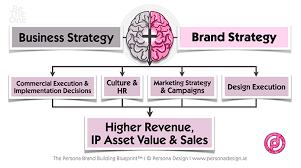The Importance of Brand Strategy Development
In today’s competitive business landscape, having a strong brand is essential for standing out and connecting with your target audience. However, building a successful brand goes beyond just creating a logo and catchy tagline – it requires a well-thought-out brand strategy.
What is Brand Strategy?
A brand strategy is a long-term plan that outlines your brand’s goals, values, positioning, and messaging. It serves as a roadmap for how you will communicate with your audience, differentiate yourself from competitors, and ultimately build brand loyalty.
The Benefits of Brand Strategy Development
Consistency: A well-defined brand strategy ensures that your messaging, visuals, and overall brand experience are consistent across all touchpoints. This consistency helps build trust and credibility with your audience.
Differentiation: By developing a unique brand strategy, you can differentiate yourself from competitors and carve out a distinct identity in the market. This differentiation is crucial for attracting customers and creating lasting impressions.
Customer Connection: A strong brand strategy helps you connect with your target audience on a deeper level by communicating your values and resonating with their needs and desires. This emotional connection can lead to increased customer loyalty and advocacy.
Key Elements of Brand Strategy
Brand Identity: This includes your logo, colours, typography, and visual elements that represent your brand visually.
Brand Messaging: Your brand voice, tone, key messages, and storytelling approach that convey your brand’s personality and values.
Target Audience: Understanding who your ideal customers are and how to tailor your branding to resonate with their preferences.
In Conclusion
A well-crafted brand strategy is the foundation of any successful branding effort. It guides how you present yourself to the world, shapes how consumers perceive you, and ultimately influences their purchasing decisions. Investing time and resources into developing a robust brand strategy can pay off in terms of increased brand awareness, customer loyalty, and business growth.
Nine Benefits of Brand Strategy Development: From Recognition to Growth
- Builds brand recognition and awareness
- Creates a consistent brand experience
- Helps differentiate your brand from competitors
- Builds trust and credibility with customers
- Guides marketing and communication efforts
- Increases customer loyalty and advocacy
- Aligns internal teams around a common vision
- Supports long-term business growth
- Enhances overall brand value
Challenges in Brand Strategy Development: Resource Demands, Complexity, Change Resistance, and Market Dynamics
Builds brand recognition and awareness
Building brand recognition and awareness is a key benefit of developing a strong brand strategy. By consistently communicating your brand values, messaging, and visual identity across various channels, you can increase your brand’s visibility and make it more memorable to your target audience. This heightened recognition not only helps in attracting new customers but also fosters a sense of trust and familiarity among existing ones, ultimately leading to long-term brand loyalty and success.
Creates a consistent brand experience
Creating a consistent brand experience is a key benefit of brand strategy development. By defining and aligning all aspects of your brand, including messaging, visuals, and tone of voice, you ensure that your audience receives a cohesive and unified message across all touchpoints. This consistency helps build trust with your customers, reinforces brand recognition, and sets you apart from competitors. A consistent brand experience not only enhances brand recall but also fosters a sense of reliability and credibility among your target audience.
Helps differentiate your brand from competitors
In a crowded marketplace, one significant advantage of developing a brand strategy is its ability to differentiate your brand from competitors. By defining your unique value proposition, key messaging, and visual identity, a well-crafted brand strategy sets you apart in the minds of consumers. This differentiation not only helps attract attention and stand out in a sea of similar offerings but also establishes a memorable and distinctive brand presence that resonates with your target audience.
Builds trust and credibility with customers
Building trust and credibility with customers is a significant benefit of brand strategy development. By maintaining consistency in messaging, visuals, and overall brand experience across all touchpoints, a well-defined brand strategy assures customers of the brand’s reliability and authenticity. This trust forms the foundation of strong customer relationships, leading to increased loyalty and advocacy. Customers are more likely to engage with brands they trust, making brand strategy an essential tool for fostering lasting connections with target audiences.
Guides marketing and communication efforts
One significant benefit of brand strategy development is that it guides marketing and communication efforts. By establishing a clear brand strategy, businesses can align their marketing campaigns and communication tactics with the brand’s values, messaging, and positioning. This alignment ensures consistency in how the brand is presented to the target audience across various channels, leading to more effective and impactful marketing initiatives that resonate with consumers and strengthen brand identity.
Increases customer loyalty and advocacy
One significant benefit of brand strategy development is its ability to increase customer loyalty and advocacy. By creating a strong and consistent brand identity that resonates with your target audience, you can build a deeper emotional connection with customers. This connection leads to greater trust, satisfaction, and loyalty towards your brand. Loyal customers are more likely to become brand advocates, spreading positive word-of-mouth recommendations and contributing to long-term business success.
Aligns internal teams around a common vision
Brand strategy development plays a crucial role in aligning internal teams around a common vision. By establishing a clear and unified brand strategy, all team members gain a shared understanding of the brand’s goals, values, and positioning. This alignment fosters collaboration, consistency in messaging, and a sense of purpose among employees. When everyone is working towards the same overarching vision, it creates a cohesive and harmonious work environment that ultimately leads to more effective execution of the brand strategy across all touchpoints.
Supports long-term business growth
A well-defined brand strategy plays a crucial role in supporting long-term business growth by establishing a strong foundation for sustainable success. By aligning the brand’s values, messaging, and positioning with the evolving needs of the target audience, businesses can build lasting relationships and loyalty. Consistent branding and strategic communication help to differentiate the business in a competitive market, attract new customers, and retain existing ones over time. This focus on long-term brand development not only drives immediate results but also sets the stage for continued growth and expansion in the future.
Enhances overall brand value
One significant benefit of brand strategy development is that it enhances the overall brand value. By carefully crafting a brand strategy that aligns with the company’s values, mission, and target audience, businesses can elevate their brand perception in the eyes of consumers. A strong brand strategy helps to differentiate the brand from competitors, build trust and credibility, and create a positive emotional connection with customers. As a result, the enhanced brand value can lead to increased customer loyalty, higher perceived quality, and ultimately greater long-term success in the market.
Resource Intensive
Developing a comprehensive brand strategy can be a daunting task for businesses, primarily due to its resource-intensive nature. The process demands a significant amount of time, effort, and financial investment, which can pose challenges for some organisations, especially smaller ones with limited resources. Allocating the necessary resources towards brand strategy development may require careful planning and prioritisation to ensure that the benefits outweigh the costs in the long run. Despite these challenges, businesses that are able to commit to the process often reap the rewards of a well-defined brand that resonates with their target audience and sets them apart in a crowded market.
Overcomplication
Overcomplication in brand strategy development poses a significant challenge as it can result in confusion among team members and dilution of the core message. When a brand strategy becomes overly complex, it may hinder effective communication and implementation within the organisation. Team members may struggle to understand and align with the strategy, leading to inconsistencies in messaging and branding efforts. Simplifying the brand strategy is essential to ensure clarity, coherence, and unity in conveying the brand’s identity and values across all channels.
Resistance to Change
Resistance to Change is a significant con of brand strategy development as it can hinder the successful implementation of a new branding direction. Stakeholders who have grown accustomed to the current branding or are hesitant about change may resist embracing a new brand strategy. This resistance can lead to internal conflicts, delays in execution, and challenges in gaining buy-in for the proposed changes. Overcoming resistance to change requires effective communication, stakeholder engagement, and demonstrating the benefits of the new brand strategy to ensure a smooth transition and alignment across all levels of the organisation.
Market Dynamics
In the realm of brand strategy development, one significant con to consider is the impact of market dynamics. External factors, such as shifting market trends and competitor actions, have the potential to disrupt even the most meticulously planned brand strategy. What may have been a relevant and effective approach at one point could quickly become outdated or less impactful in response to evolving market conditions. This highlights the importance of ongoing monitoring and flexibility in adapting brand strategies to stay aligned with the ever-changing business landscape.

